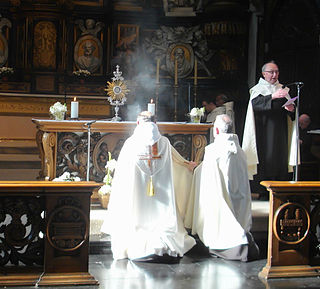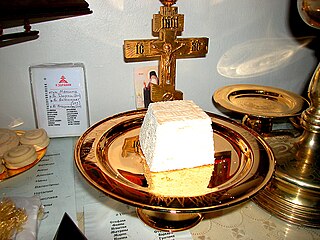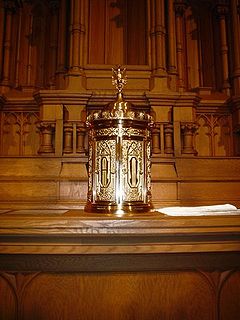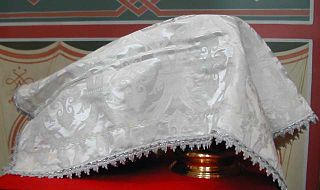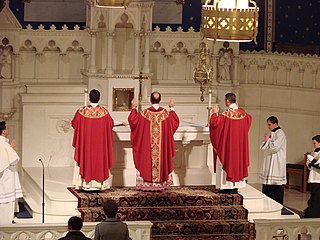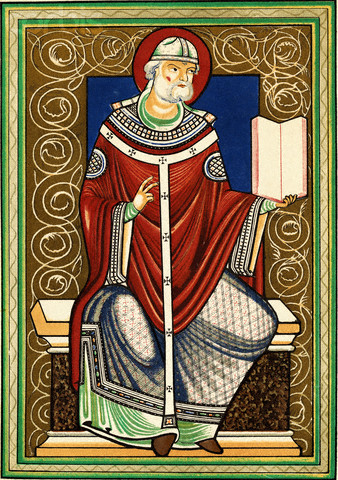

The Divine Liturgy of the Presanctified Gifts is a Byzantine Rite liturgical service which is performed on the weekdays of Great Lent wherein communion is received from Gifts (the Body and Blood of Christ) that are sanctified (consecrated) in advance, hence its name; this Divine Liturgy has no anaphora (eucharistic prayer).
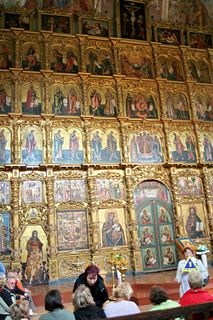
The Byzantine Rite, also known as the Greek Rite or Constantinopolitan Rite, is the liturgical rite used by the Eastern Orthodox Church, the Greek/Byzantine Catholic churches, and in a modified form, Byzantine Rite Lutheranism. Its development began during the fourth century in Constantinople and it is now the second most-used ecclesiastical rite in Christendom after the Roman Rite.

Great Lent, or the Great Fast, is the most important fasting season in the church year in the Byzantine Rite of the Eastern Orthodox Church, Byzantine Rite Lutheran Churches and the Eastern Catholic Churches, which prepares Christians for the greatest feast of the church year, Pascha (Easter).

The Eucharist is a Christian rite that is considered a sacrament in most churches, and as an ordinance in others. According to the New Testament, the rite was instituted by Jesus Christ during the Last Supper; giving his disciples bread and wine during the Passover meal, Jesus commanded his followers to "do this in memory of me" while referring to the bread as "my body" and the cup of wine as "the new covenant in my blood". Through the Eucharistic celebration Christians remember both Christ's sacrifice of himself on the cross and his commission of the apostles at the Last Supper.
Contents
- Celebration
- Preparation
- History
- Other liturgical traditions
- References
- External links
- Texts of the liturgy
- Musical settings
- Notes
The Presanctified is used on the weekdays of Great Lent, a season of repentance, fasting, and intensified prayer when the more frequent reception of communion is desirable; however, the full Divine Liturgy having a joyful character is not in keeping with the somberness of the season of repentance (Eucharist literally means "thanksgiving") and so the Presanctified is substituted. Although this service may be performed on any weekday (Monday through Friday) of Great Lent, common parish practice is to celebrate it only on Wednesdays, Fridays, and a feast day on which the polyeleos is sung that falls on a weekday. The Typicon also prescribes the Presanctified on the Thursday of the Great Canon (the fifth Thursday of Lent), and on first three days of Holy Week.
Repentance is the activity of reviewing one's actions and feeling contrition or regret for past wrongs, which is accompanied by commitment to change for the better. In modern times, it is generally seen as involving a commitment to personal change and the resolve to live a more responsible and humane life. In other words, being sorry for one's misdeeds. But it can also involve sorrow over a specific sin or series of sins that an individual feels he or she has committed. The practice of repentance plays an important role in the soteriological doctrines of Judaism, Christianity, and Islam. Analogous practices have been found in other world religions as well. In religious contexts, it often involves an act of confession to God or to a spiritual elder. This confession might include an admission of guilt, a promise or intent not to repeat the offense, an attempt to make restitution for the wrong, or in some way reverse the harmful effects of the wrong where possible. As such it can be seen as being similar to therapeutic practices though it clearly differs in its particulars.
Fasting is the willing abstinence or reduction from some or all food, drink, or both, for a period of time. An absolute fast or dry fasting is normally defined as abstinence from all food and liquid for a defined period. Water fasting refers to abstinence from all food and drink except water, but black coffee and tea may be consumed. Other fasts may be partially restrictive, limiting only particular foods or substances, or be intermittent.

Prayer is an invocation or act that seeks to activate a rapport with an object of worship, typically a deity, through deliberate communication. In the narrow sense, the term refers to an act of supplication or intercession directed towards a deity, or a deified ancestor. More generally, prayer can also have the purpose of thanksgiving or praise, and in comparative religion is closely associated with more abstract forms of meditation and with charms or spells.









